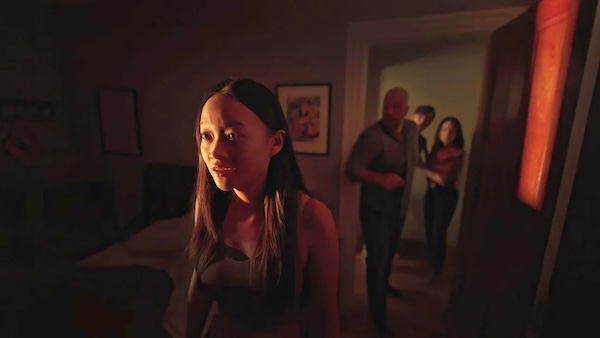Film Review: “Presence” — The Spectre of the Middle Class
By Steve Erickson
More than the threat posed by the ghost, Presence is desperately terrified of ambiguity.
Presence, directed by Steven Soderbergh. Screening at Alamo Drafthouse Boston

Callina Liang in Presence. Photo: courtesy of Neon
Presence supplies a take-away lesson: many fathers would love a paranormal entity who helps them take care of their teenage daughters. The film adopts a singular narrative strategy: this is a haunted house story in which the camera takes the ghost’s point of view. A roving Steadicam represents the vision of the poltergeist. (Taking the pseudonym Peter Andrews, Soderbergh served as his own cinematographer, physically moving a camera, which was strapped to his body.) The approach would be perfect for a first-person killer-cam in a slasher movie, but Presence puts the perspective to a more benevolent use. Veteran writer David Koepp’s script works from a premise that falls into an ultra- conservative horror film groove: an unknown outsider endangers a nuclear family, posing the greatest danger to a girl. Koepp is self-aware enough to put a twist on this set-up. The basic concept may be old-fashioned, but the fears are very contemporary: sexting, deaths from fentanyl as a result of casual drug use, a generation of boys who embrace misogyny and bullying.
At first, the entity roams around an empty house. Married couple Chris (Chris Sullivan) and Rebecca Payne (Lucy Liu), with their teenage children Chloe (Callina Liang) and Tyler (Eddie Mayday), come to have a look. They immediately decide to buy the home and move in. Unbeknownst to the family, they’re being watched. Those who believe in ghosts posit that poltergeists are particularly attracted to teenage girls; accordingly, Chloe becomes the focus of the haunting. The entity plays tricks on her, such as moving her books while she steps out of her room. It takes up watch in her closet. An alarmed family invites a psychic over for advice, even though she shows signs of being a grifter.
Presence comes across more as a drama about a troubled family than a horror film. It treats the fact that the Paynes always order take-out, even if they can afford to do so regularly and in large amounts, as a social symbol of turmoil. Rebecca is absorbed by her troubles at work, though what they are is never explained. Still, there’s a strong suggestion that crime may be the reason they can afford to buy the house. Chris is perpetually worried; he tries to look calmer than he really is. He’s framed in ways that show him standing watch, yet suggests the limits of his vision. At one point, he calls a lawyer to ask about his liability for illegal actions that were possibly taken by Rebecca. He’s acutely aware of his failure to protect his wife and children, especially from themselves. The other characters in this domestic drama are much more thinly sketched; Tyler is a caricature of a dim, mean-spirited bro and Rebecca is little more than a stereotype of an icy businesswoman. The emphatic domesticity of the film’s plot, its tiny cast and single setting, make it feel like a made-for-TV movie.
More than the threat posed by the ghost, Presence is desperately terrified of ambiguity. The narrative is filled with foreshadowing, religious allusions that pay off in predictable ways. Chris was named after Christ by his devout Catholic mother, and the family’s house is full of mock-stained glass crosses. The film uses mirrors as portals for the ghost. (As for the artwork featuring owls in Chloe’s bedroom, Soderbergh must be alluding to the famous Twin Peaks line “the owls are not what they seem.”) The ghost signals its arrival with an electronic buzz, like a quiet smoke alarm. Along with the camera serving as its ‘eye’, this keeps the audience aware of its existence.
The ghost is cast in the role of voyeur. It functions like a parental hidden camera in their daughter’s room. It drifts into extreme close-ups, taken near the actors’ faces, a wide camera lens distorting the view further. At its most active, the spook becomes a physical force, knocking danger away. You can’t help but feel that Soderbergh was having a great time trying out new ideas shooting this way, but in ways that are completely disconnected from the characters and narrative. Themes about filmmaking and the camera’s gaze underlie Presence, but they are far removed from Koepp’s fairly rote script. The ghost may represent the director’s vision and body’s movements, but his personal investment in the narrative is never apparent. There’s no heart here, just technical expertise.
In his annual list of the films he watched, Soderbergh mentioned seeing Joel Anderson’s Lake Mungo last year. The Australian found-footage ghost story tackles many of the same anxieties as Presence, especially menaces to girls in middle-class families. In his book The Weird and the Eerie, Mark Fisher defined the uncanny by its ability to place “the strange inside the familiar.” In other words, the call of danger (or just the unknowable) is coming from within the house. They may share the same supernatural conceit, but tonally Lake Mungo and Presence are far apart: the former uses horror to examine loss and our collective inability to really know each other, capped by one of the eeriest final images in film history. Despite its inclusion of tragedy, Presence yearns to be optimistic and comforting. In this political moment, that’s a perfectly understandable desire, but the result tames the destabilizing potential of the paranormal. Because it yearns for safety, Presence anthropomorphizes the ghostly, turning the otherworldly into little more than a manifestation of upper-middle-class Americans’ fears.
Steve Erickson writes about film and music for Gay City News, Slant Magazine, the Nashville Scene, Trouser Press, and other outlets. He also produces electronic music under the tag callinamagician. His latest album, Bells and Whistles, was released in January 2024, and is available to stream here.
